Strategic Analysis and Consultancy Report: Uber's Cultural Change
VerifiedAdded on 2020/01/16
|24
|8914
|173
Report
AI Summary
This consultancy report examines Uber's cultural change process, focusing on its rationale, stages, and challenges. The report begins with an introduction to the company's strategies and the importance of adapting to external changes, particularly in the context of the UK market. It highlights the significance of cultural change in addressing issues like poor leadership and unethical practices, which have negatively impacted Uber's image. The report details the key elements of Uber's organizational culture and the rationale behind implementing a cultural change process, including improved business performance, responses to environmental changes, and addressing unethical activities. The core of the report outlines the stages involved in the change process, from creating awareness and identifying areas of need to diagnosing problems and developing solutions. The report also addresses potential challenges, such as resistance to change and communication issues, and offers solutions like effective communication and employee involvement. The report concludes with a discussion of the results of the change process and a reflective analysis of the learning outcomes.
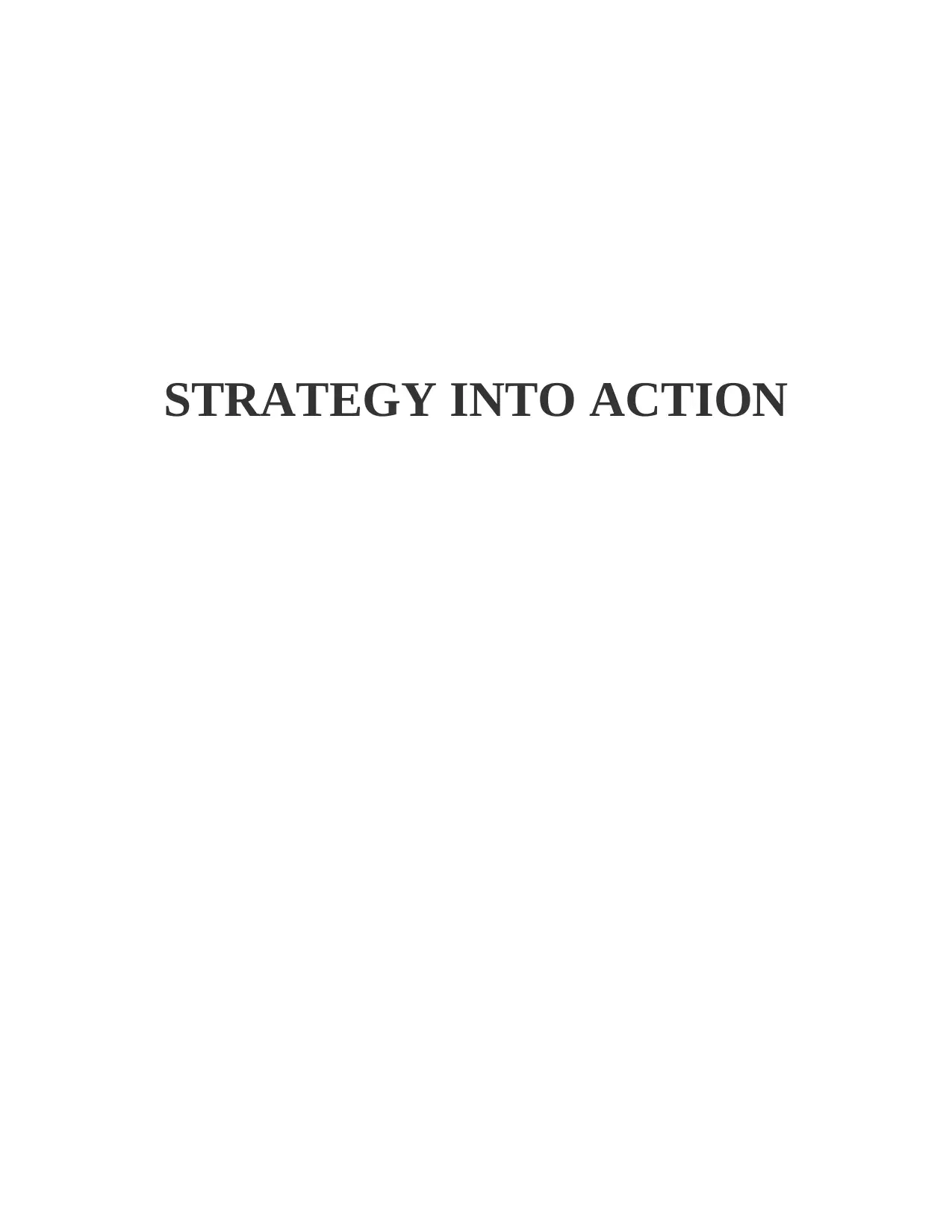
STRATEGY INTO ACTION
Paraphrase This Document
Need a fresh take? Get an instant paraphrase of this document with our AI Paraphraser
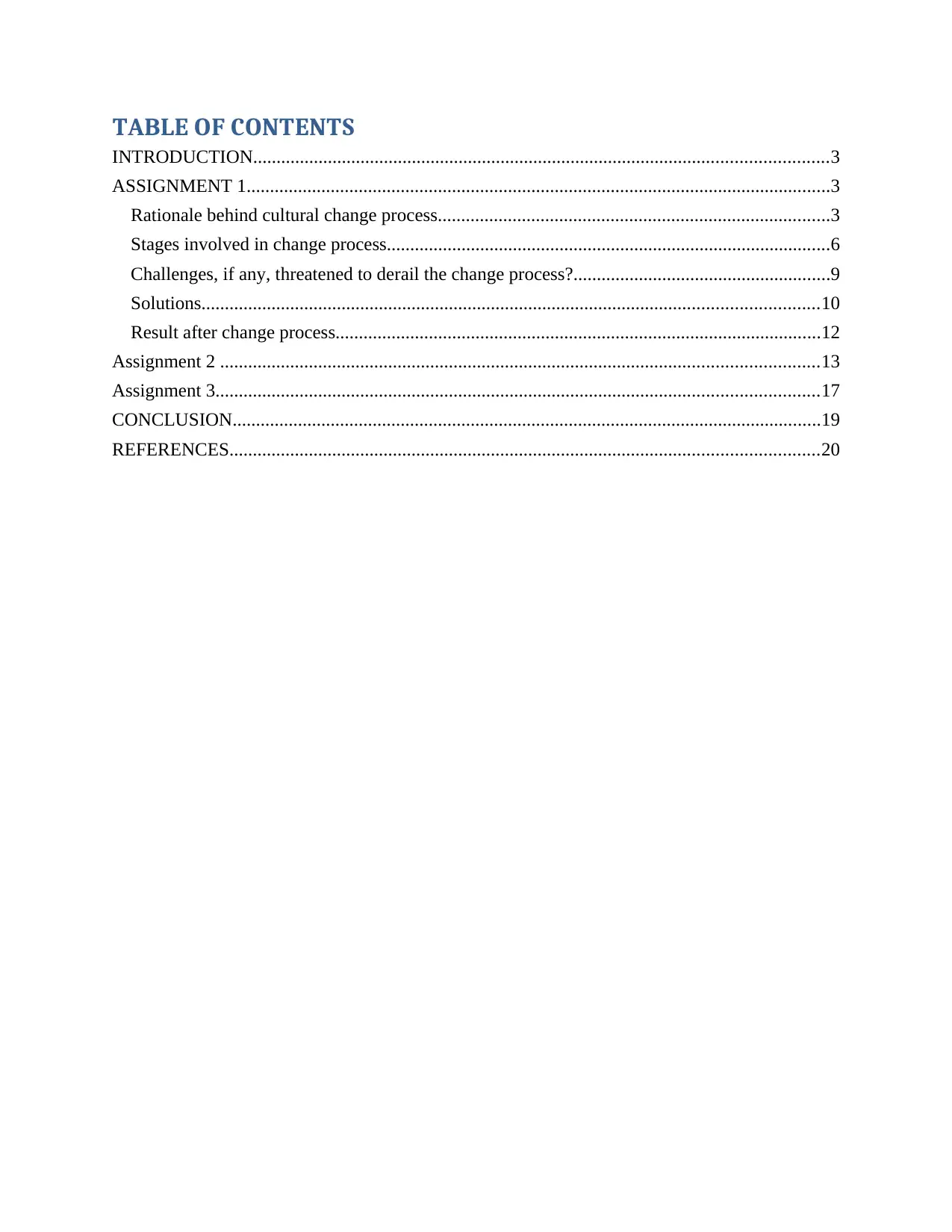
TABLE OF CONTENTS
INTRODUCTION...........................................................................................................................3
ASSIGNMENT 1.............................................................................................................................3
Rationale behind cultural change process....................................................................................3
Stages involved in change process...............................................................................................6
Challenges, if any, threatened to derail the change process?.......................................................9
Solutions....................................................................................................................................10
Result after change process........................................................................................................12
Assignment 2 ................................................................................................................................13
Assignment 3.................................................................................................................................17
CONCLUSION..............................................................................................................................19
REFERENCES..............................................................................................................................20
INTRODUCTION...........................................................................................................................3
ASSIGNMENT 1.............................................................................................................................3
Rationale behind cultural change process....................................................................................3
Stages involved in change process...............................................................................................6
Challenges, if any, threatened to derail the change process?.......................................................9
Solutions....................................................................................................................................10
Result after change process........................................................................................................12
Assignment 2 ................................................................................................................................13
Assignment 3.................................................................................................................................17
CONCLUSION..............................................................................................................................19
REFERENCES..............................................................................................................................20
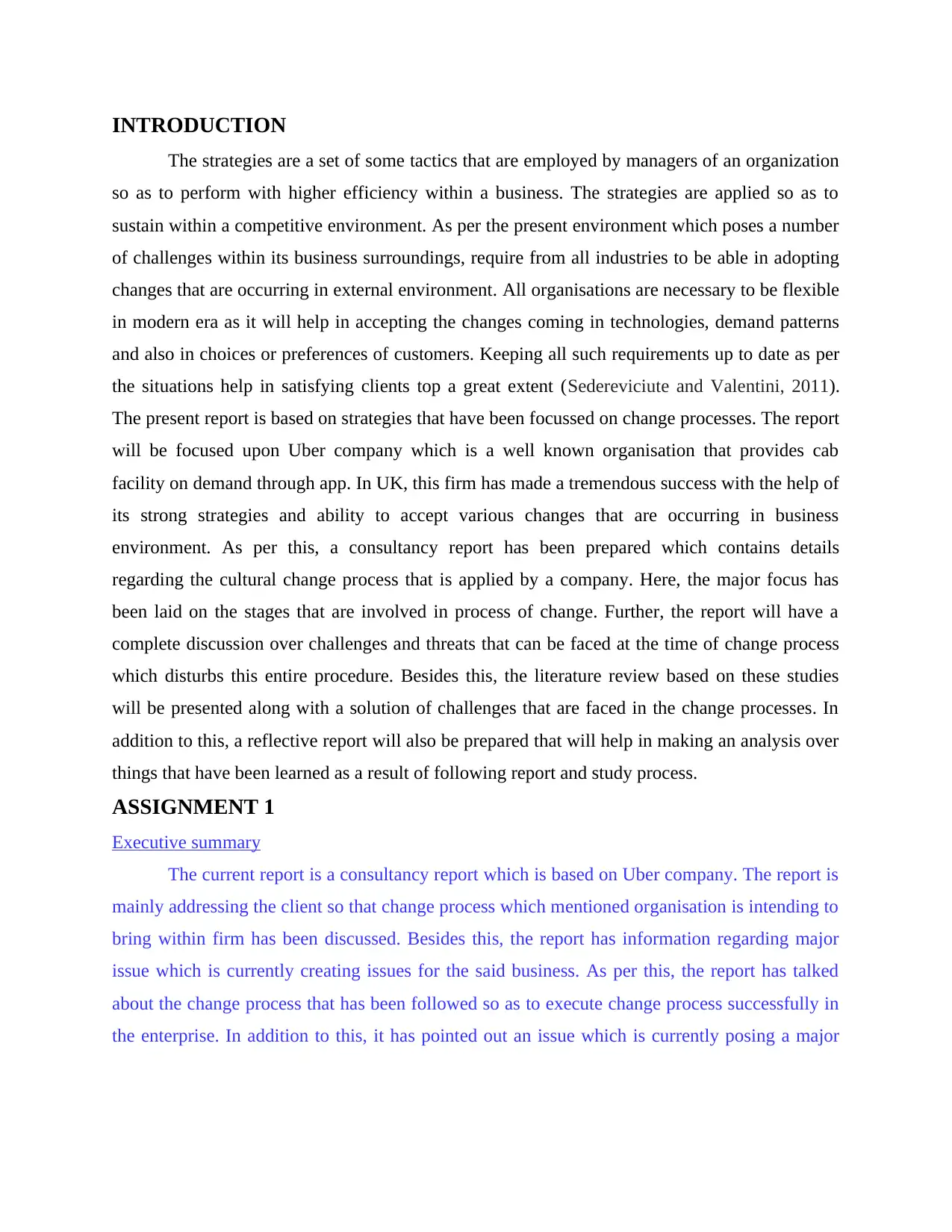
INTRODUCTION
The strategies are a set of some tactics that are employed by managers of an organization
so as to perform with higher efficiency within a business. The strategies are applied so as to
sustain within a competitive environment. As per the present environment which poses a number
of challenges within its business surroundings, require from all industries to be able in adopting
changes that are occurring in external environment. All organisations are necessary to be flexible
in modern era as it will help in accepting the changes coming in technologies, demand patterns
and also in choices or preferences of customers. Keeping all such requirements up to date as per
the situations help in satisfying clients top a great extent (Sedereviciute and Valentini, 2011).
The present report is based on strategies that have been focussed on change processes. The report
will be focused upon Uber company which is a well known organisation that provides cab
facility on demand through app. In UK, this firm has made a tremendous success with the help of
its strong strategies and ability to accept various changes that are occurring in business
environment. As per this, a consultancy report has been prepared which contains details
regarding the cultural change process that is applied by a company. Here, the major focus has
been laid on the stages that are involved in process of change. Further, the report will have a
complete discussion over challenges and threats that can be faced at the time of change process
which disturbs this entire procedure. Besides this, the literature review based on these studies
will be presented along with a solution of challenges that are faced in the change processes. In
addition to this, a reflective report will also be prepared that will help in making an analysis over
things that have been learned as a result of following report and study process.
ASSIGNMENT 1
Executive summary
The current report is a consultancy report which is based on Uber company. The report is
mainly addressing the client so that change process which mentioned organisation is intending to
bring within firm has been discussed. Besides this, the report has information regarding major
issue which is currently creating issues for the said business. As per this, the report has talked
about the change process that has been followed so as to execute change process successfully in
the enterprise. In addition to this, it has pointed out an issue which is currently posing a major
The strategies are a set of some tactics that are employed by managers of an organization
so as to perform with higher efficiency within a business. The strategies are applied so as to
sustain within a competitive environment. As per the present environment which poses a number
of challenges within its business surroundings, require from all industries to be able in adopting
changes that are occurring in external environment. All organisations are necessary to be flexible
in modern era as it will help in accepting the changes coming in technologies, demand patterns
and also in choices or preferences of customers. Keeping all such requirements up to date as per
the situations help in satisfying clients top a great extent (Sedereviciute and Valentini, 2011).
The present report is based on strategies that have been focussed on change processes. The report
will be focused upon Uber company which is a well known organisation that provides cab
facility on demand through app. In UK, this firm has made a tremendous success with the help of
its strong strategies and ability to accept various changes that are occurring in business
environment. As per this, a consultancy report has been prepared which contains details
regarding the cultural change process that is applied by a company. Here, the major focus has
been laid on the stages that are involved in process of change. Further, the report will have a
complete discussion over challenges and threats that can be faced at the time of change process
which disturbs this entire procedure. Besides this, the literature review based on these studies
will be presented along with a solution of challenges that are faced in the change processes. In
addition to this, a reflective report will also be prepared that will help in making an analysis over
things that have been learned as a result of following report and study process.
ASSIGNMENT 1
Executive summary
The current report is a consultancy report which is based on Uber company. The report is
mainly addressing the client so that change process which mentioned organisation is intending to
bring within firm has been discussed. Besides this, the report has information regarding major
issue which is currently creating issues for the said business. As per this, the report has talked
about the change process that has been followed so as to execute change process successfully in
the enterprise. In addition to this, it has pointed out an issue which is currently posing a major
⊘ This is a preview!⊘
Do you want full access?
Subscribe today to unlock all pages.

Trusted by 1+ million students worldwide
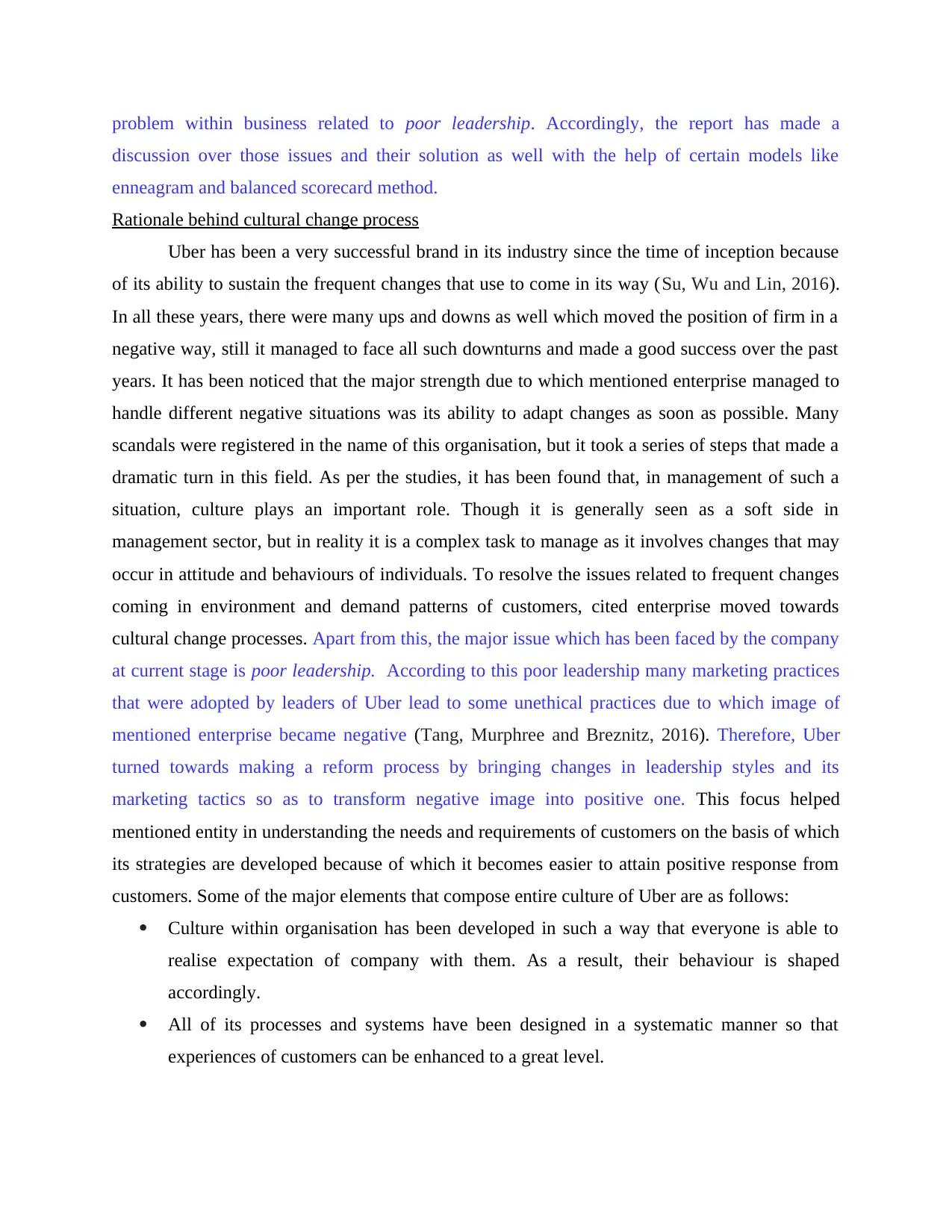
problem within business related to poor leadership. Accordingly, the report has made a
discussion over those issues and their solution as well with the help of certain models like
enneagram and balanced scorecard method.
Rationale behind cultural change process
Uber has been a very successful brand in its industry since the time of inception because
of its ability to sustain the frequent changes that use to come in its way (Su, Wu and Lin, 2016).
In all these years, there were many ups and downs as well which moved the position of firm in a
negative way, still it managed to face all such downturns and made a good success over the past
years. It has been noticed that the major strength due to which mentioned enterprise managed to
handle different negative situations was its ability to adapt changes as soon as possible. Many
scandals were registered in the name of this organisation, but it took a series of steps that made a
dramatic turn in this field. As per the studies, it has been found that, in management of such a
situation, culture plays an important role. Though it is generally seen as a soft side in
management sector, but in reality it is a complex task to manage as it involves changes that may
occur in attitude and behaviours of individuals. To resolve the issues related to frequent changes
coming in environment and demand patterns of customers, cited enterprise moved towards
cultural change processes. Apart from this, the major issue which has been faced by the company
at current stage is poor leadership. According to this poor leadership many marketing practices
that were adopted by leaders of Uber lead to some unethical practices due to which image of
mentioned enterprise became negative (Tang, Murphree and Breznitz, 2016). Therefore, Uber
turned towards making a reform process by bringing changes in leadership styles and its
marketing tactics so as to transform negative image into positive one. This focus helped
mentioned entity in understanding the needs and requirements of customers on the basis of which
its strategies are developed because of which it becomes easier to attain positive response from
customers. Some of the major elements that compose entire culture of Uber are as follows:
Culture within organisation has been developed in such a way that everyone is able to
realise expectation of company with them. As a result, their behaviour is shaped
accordingly.
All of its processes and systems have been designed in a systematic manner so that
experiences of customers can be enhanced to a great level.
discussion over those issues and their solution as well with the help of certain models like
enneagram and balanced scorecard method.
Rationale behind cultural change process
Uber has been a very successful brand in its industry since the time of inception because
of its ability to sustain the frequent changes that use to come in its way (Su, Wu and Lin, 2016).
In all these years, there were many ups and downs as well which moved the position of firm in a
negative way, still it managed to face all such downturns and made a good success over the past
years. It has been noticed that the major strength due to which mentioned enterprise managed to
handle different negative situations was its ability to adapt changes as soon as possible. Many
scandals were registered in the name of this organisation, but it took a series of steps that made a
dramatic turn in this field. As per the studies, it has been found that, in management of such a
situation, culture plays an important role. Though it is generally seen as a soft side in
management sector, but in reality it is a complex task to manage as it involves changes that may
occur in attitude and behaviours of individuals. To resolve the issues related to frequent changes
coming in environment and demand patterns of customers, cited enterprise moved towards
cultural change processes. Apart from this, the major issue which has been faced by the company
at current stage is poor leadership. According to this poor leadership many marketing practices
that were adopted by leaders of Uber lead to some unethical practices due to which image of
mentioned enterprise became negative (Tang, Murphree and Breznitz, 2016). Therefore, Uber
turned towards making a reform process by bringing changes in leadership styles and its
marketing tactics so as to transform negative image into positive one. This focus helped
mentioned entity in understanding the needs and requirements of customers on the basis of which
its strategies are developed because of which it becomes easier to attain positive response from
customers. Some of the major elements that compose entire culture of Uber are as follows:
Culture within organisation has been developed in such a way that everyone is able to
realise expectation of company with them. As a result, their behaviour is shaped
accordingly.
All of its processes and systems have been designed in a systematic manner so that
experiences of customers can be enhanced to a great level.
Paraphrase This Document
Need a fresh take? Get an instant paraphrase of this document with our AI Paraphraser
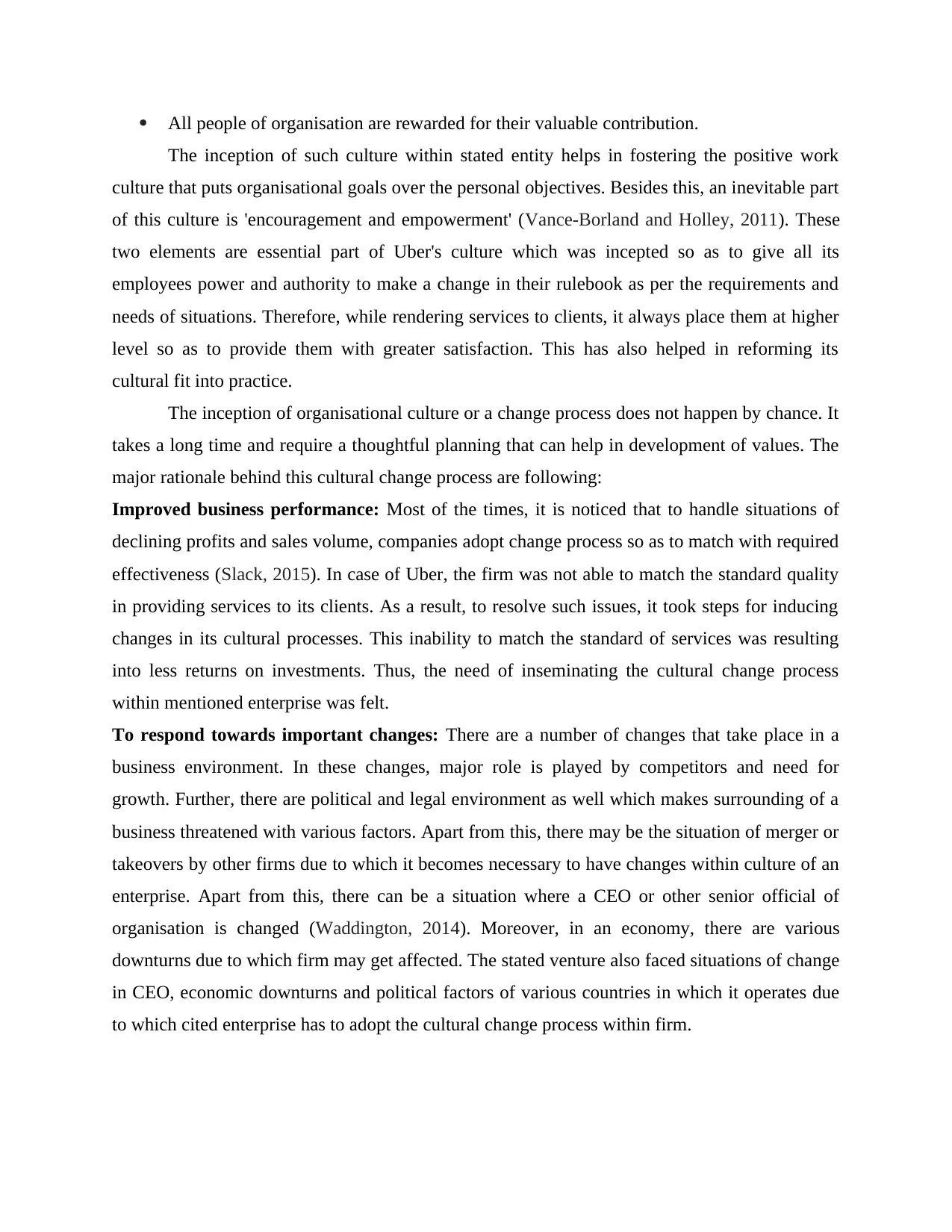
All people of organisation are rewarded for their valuable contribution.
The inception of such culture within stated entity helps in fostering the positive work
culture that puts organisational goals over the personal objectives. Besides this, an inevitable part
of this culture is 'encouragement and empowerment' (Vance‐Borland and Holley, 2011). These
two elements are essential part of Uber's culture which was incepted so as to give all its
employees power and authority to make a change in their rulebook as per the requirements and
needs of situations. Therefore, while rendering services to clients, it always place them at higher
level so as to provide them with greater satisfaction. This has also helped in reforming its
cultural fit into practice.
The inception of organisational culture or a change process does not happen by chance. It
takes a long time and require a thoughtful planning that can help in development of values. The
major rationale behind this cultural change process are following:
Improved business performance: Most of the times, it is noticed that to handle situations of
declining profits and sales volume, companies adopt change process so as to match with required
effectiveness (Slack, 2015). In case of Uber, the firm was not able to match the standard quality
in providing services to its clients. As a result, to resolve such issues, it took steps for inducing
changes in its cultural processes. This inability to match the standard of services was resulting
into less returns on investments. Thus, the need of inseminating the cultural change process
within mentioned enterprise was felt.
To respond towards important changes: There are a number of changes that take place in a
business environment. In these changes, major role is played by competitors and need for
growth. Further, there are political and legal environment as well which makes surrounding of a
business threatened with various factors. Apart from this, there may be the situation of merger or
takeovers by other firms due to which it becomes necessary to have changes within culture of an
enterprise. Apart from this, there can be a situation where a CEO or other senior official of
organisation is changed (Waddington, 2014). Moreover, in an economy, there are various
downturns due to which firm may get affected. The stated venture also faced situations of change
in CEO, economic downturns and political factors of various countries in which it operates due
to which cited enterprise has to adopt the cultural change process within firm.
The inception of such culture within stated entity helps in fostering the positive work
culture that puts organisational goals over the personal objectives. Besides this, an inevitable part
of this culture is 'encouragement and empowerment' (Vance‐Borland and Holley, 2011). These
two elements are essential part of Uber's culture which was incepted so as to give all its
employees power and authority to make a change in their rulebook as per the requirements and
needs of situations. Therefore, while rendering services to clients, it always place them at higher
level so as to provide them with greater satisfaction. This has also helped in reforming its
cultural fit into practice.
The inception of organisational culture or a change process does not happen by chance. It
takes a long time and require a thoughtful planning that can help in development of values. The
major rationale behind this cultural change process are following:
Improved business performance: Most of the times, it is noticed that to handle situations of
declining profits and sales volume, companies adopt change process so as to match with required
effectiveness (Slack, 2015). In case of Uber, the firm was not able to match the standard quality
in providing services to its clients. As a result, to resolve such issues, it took steps for inducing
changes in its cultural processes. This inability to match the standard of services was resulting
into less returns on investments. Thus, the need of inseminating the cultural change process
within mentioned enterprise was felt.
To respond towards important changes: There are a number of changes that take place in a
business environment. In these changes, major role is played by competitors and need for
growth. Further, there are political and legal environment as well which makes surrounding of a
business threatened with various factors. Apart from this, there may be the situation of merger or
takeovers by other firms due to which it becomes necessary to have changes within culture of an
enterprise. Apart from this, there can be a situation where a CEO or other senior official of
organisation is changed (Waddington, 2014). Moreover, in an economy, there are various
downturns due to which firm may get affected. The stated venture also faced situations of change
in CEO, economic downturns and political factors of various countries in which it operates due
to which cited enterprise has to adopt the cultural change process within firm.
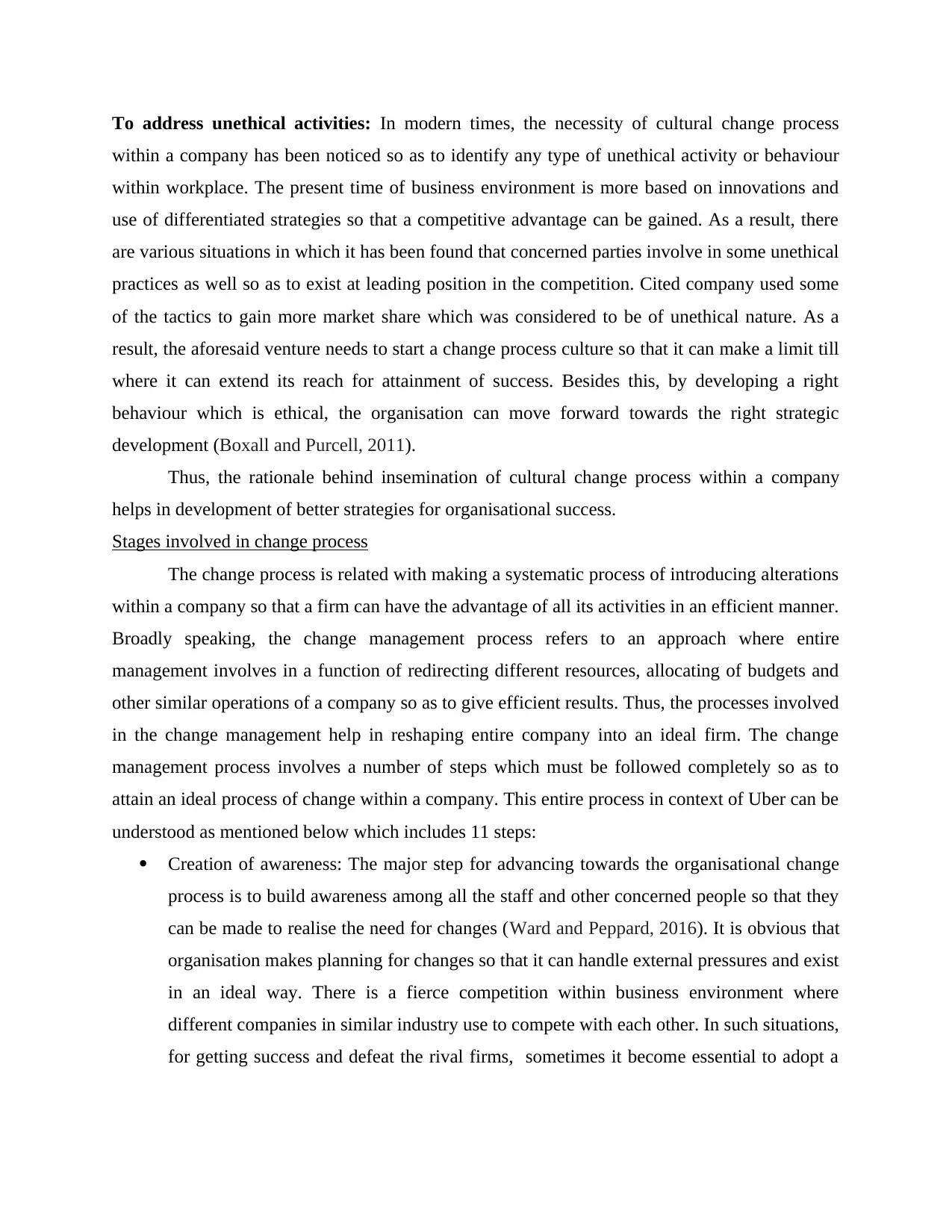
To address unethical activities: In modern times, the necessity of cultural change process
within a company has been noticed so as to identify any type of unethical activity or behaviour
within workplace. The present time of business environment is more based on innovations and
use of differentiated strategies so that a competitive advantage can be gained. As a result, there
are various situations in which it has been found that concerned parties involve in some unethical
practices as well so as to exist at leading position in the competition. Cited company used some
of the tactics to gain more market share which was considered to be of unethical nature. As a
result, the aforesaid venture needs to start a change process culture so that it can make a limit till
where it can extend its reach for attainment of success. Besides this, by developing a right
behaviour which is ethical, the organisation can move forward towards the right strategic
development (Boxall and Purcell, 2011).
Thus, the rationale behind insemination of cultural change process within a company
helps in development of better strategies for organisational success.
Stages involved in change process
The change process is related with making a systematic process of introducing alterations
within a company so that a firm can have the advantage of all its activities in an efficient manner.
Broadly speaking, the change management process refers to an approach where entire
management involves in a function of redirecting different resources, allocating of budgets and
other similar operations of a company so as to give efficient results. Thus, the processes involved
in the change management help in reshaping entire company into an ideal firm. The change
management process involves a number of steps which must be followed completely so as to
attain an ideal process of change within a company. This entire process in context of Uber can be
understood as mentioned below which includes 11 steps:
Creation of awareness: The major step for advancing towards the organisational change
process is to build awareness among all the staff and other concerned people so that they
can be made to realise the need for changes (Ward and Peppard, 2016). It is obvious that
organisation makes planning for changes so that it can handle external pressures and exist
in an ideal way. There is a fierce competition within business environment where
different companies in similar industry use to compete with each other. In such situations,
for getting success and defeat the rival firms, sometimes it become essential to adopt a
within a company has been noticed so as to identify any type of unethical activity or behaviour
within workplace. The present time of business environment is more based on innovations and
use of differentiated strategies so that a competitive advantage can be gained. As a result, there
are various situations in which it has been found that concerned parties involve in some unethical
practices as well so as to exist at leading position in the competition. Cited company used some
of the tactics to gain more market share which was considered to be of unethical nature. As a
result, the aforesaid venture needs to start a change process culture so that it can make a limit till
where it can extend its reach for attainment of success. Besides this, by developing a right
behaviour which is ethical, the organisation can move forward towards the right strategic
development (Boxall and Purcell, 2011).
Thus, the rationale behind insemination of cultural change process within a company
helps in development of better strategies for organisational success.
Stages involved in change process
The change process is related with making a systematic process of introducing alterations
within a company so that a firm can have the advantage of all its activities in an efficient manner.
Broadly speaking, the change management process refers to an approach where entire
management involves in a function of redirecting different resources, allocating of budgets and
other similar operations of a company so as to give efficient results. Thus, the processes involved
in the change management help in reshaping entire company into an ideal firm. The change
management process involves a number of steps which must be followed completely so as to
attain an ideal process of change within a company. This entire process in context of Uber can be
understood as mentioned below which includes 11 steps:
Creation of awareness: The major step for advancing towards the organisational change
process is to build awareness among all the staff and other concerned people so that they
can be made to realise the need for changes (Ward and Peppard, 2016). It is obvious that
organisation makes planning for changes so that it can handle external pressures and exist
in an ideal way. There is a fierce competition within business environment where
different companies in similar industry use to compete with each other. In such situations,
for getting success and defeat the rival firms, sometimes it become essential to adopt a
⊘ This is a preview!⊘
Do you want full access?
Subscribe today to unlock all pages.

Trusted by 1+ million students worldwide
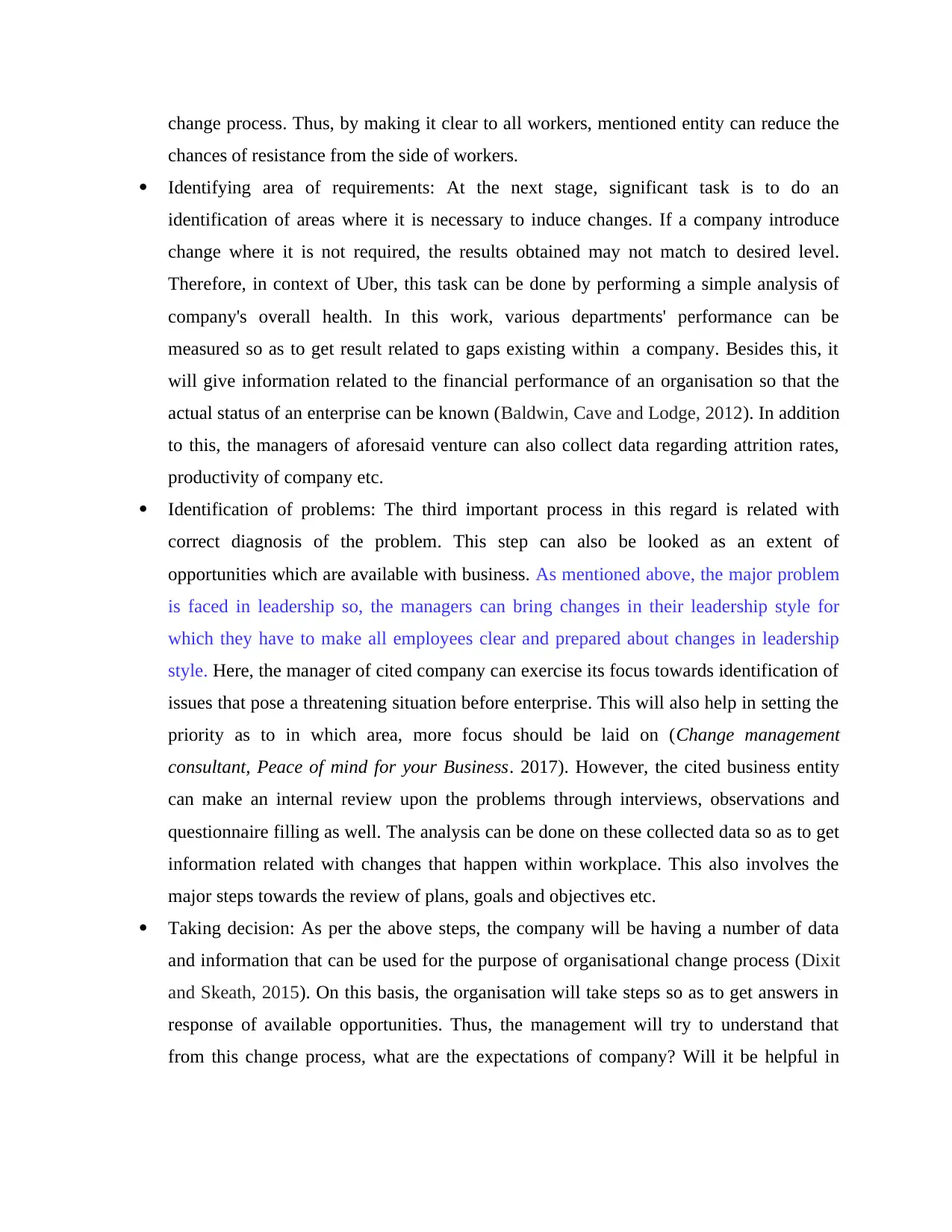
change process. Thus, by making it clear to all workers, mentioned entity can reduce the
chances of resistance from the side of workers.
Identifying area of requirements: At the next stage, significant task is to do an
identification of areas where it is necessary to induce changes. If a company introduce
change where it is not required, the results obtained may not match to desired level.
Therefore, in context of Uber, this task can be done by performing a simple analysis of
company's overall health. In this work, various departments' performance can be
measured so as to get result related to gaps existing within a company. Besides this, it
will give information related to the financial performance of an organisation so that the
actual status of an enterprise can be known (Baldwin, Cave and Lodge, 2012). In addition
to this, the managers of aforesaid venture can also collect data regarding attrition rates,
productivity of company etc.
Identification of problems: The third important process in this regard is related with
correct diagnosis of the problem. This step can also be looked as an extent of
opportunities which are available with business. As mentioned above, the major problem
is faced in leadership so, the managers can bring changes in their leadership style for
which they have to make all employees clear and prepared about changes in leadership
style. Here, the manager of cited company can exercise its focus towards identification of
issues that pose a threatening situation before enterprise. This will also help in setting the
priority as to in which area, more focus should be laid on (Change management
consultant, Peace of mind for your Business. 2017). However, the cited business entity
can make an internal review upon the problems through interviews, observations and
questionnaire filling as well. The analysis can be done on these collected data so as to get
information related with changes that happen within workplace. This also involves the
major steps towards the review of plans, goals and objectives etc.
Taking decision: As per the above steps, the company will be having a number of data
and information that can be used for the purpose of organisational change process (Dixit
and Skeath, 2015). On this basis, the organisation will take steps so as to get answers in
response of available opportunities. Thus, the management will try to understand that
from this change process, what are the expectations of company? Will it be helpful in
chances of resistance from the side of workers.
Identifying area of requirements: At the next stage, significant task is to do an
identification of areas where it is necessary to induce changes. If a company introduce
change where it is not required, the results obtained may not match to desired level.
Therefore, in context of Uber, this task can be done by performing a simple analysis of
company's overall health. In this work, various departments' performance can be
measured so as to get result related to gaps existing within a company. Besides this, it
will give information related to the financial performance of an organisation so that the
actual status of an enterprise can be known (Baldwin, Cave and Lodge, 2012). In addition
to this, the managers of aforesaid venture can also collect data regarding attrition rates,
productivity of company etc.
Identification of problems: The third important process in this regard is related with
correct diagnosis of the problem. This step can also be looked as an extent of
opportunities which are available with business. As mentioned above, the major problem
is faced in leadership so, the managers can bring changes in their leadership style for
which they have to make all employees clear and prepared about changes in leadership
style. Here, the manager of cited company can exercise its focus towards identification of
issues that pose a threatening situation before enterprise. This will also help in setting the
priority as to in which area, more focus should be laid on (Change management
consultant, Peace of mind for your Business. 2017). However, the cited business entity
can make an internal review upon the problems through interviews, observations and
questionnaire filling as well. The analysis can be done on these collected data so as to get
information related with changes that happen within workplace. This also involves the
major steps towards the review of plans, goals and objectives etc.
Taking decision: As per the above steps, the company will be having a number of data
and information that can be used for the purpose of organisational change process (Dixit
and Skeath, 2015). On this basis, the organisation will take steps so as to get answers in
response of available opportunities. Thus, the management will try to understand that
from this change process, what are the expectations of company? Will it be helpful in
Paraphrase This Document
Need a fresh take? Get an instant paraphrase of this document with our AI Paraphraser
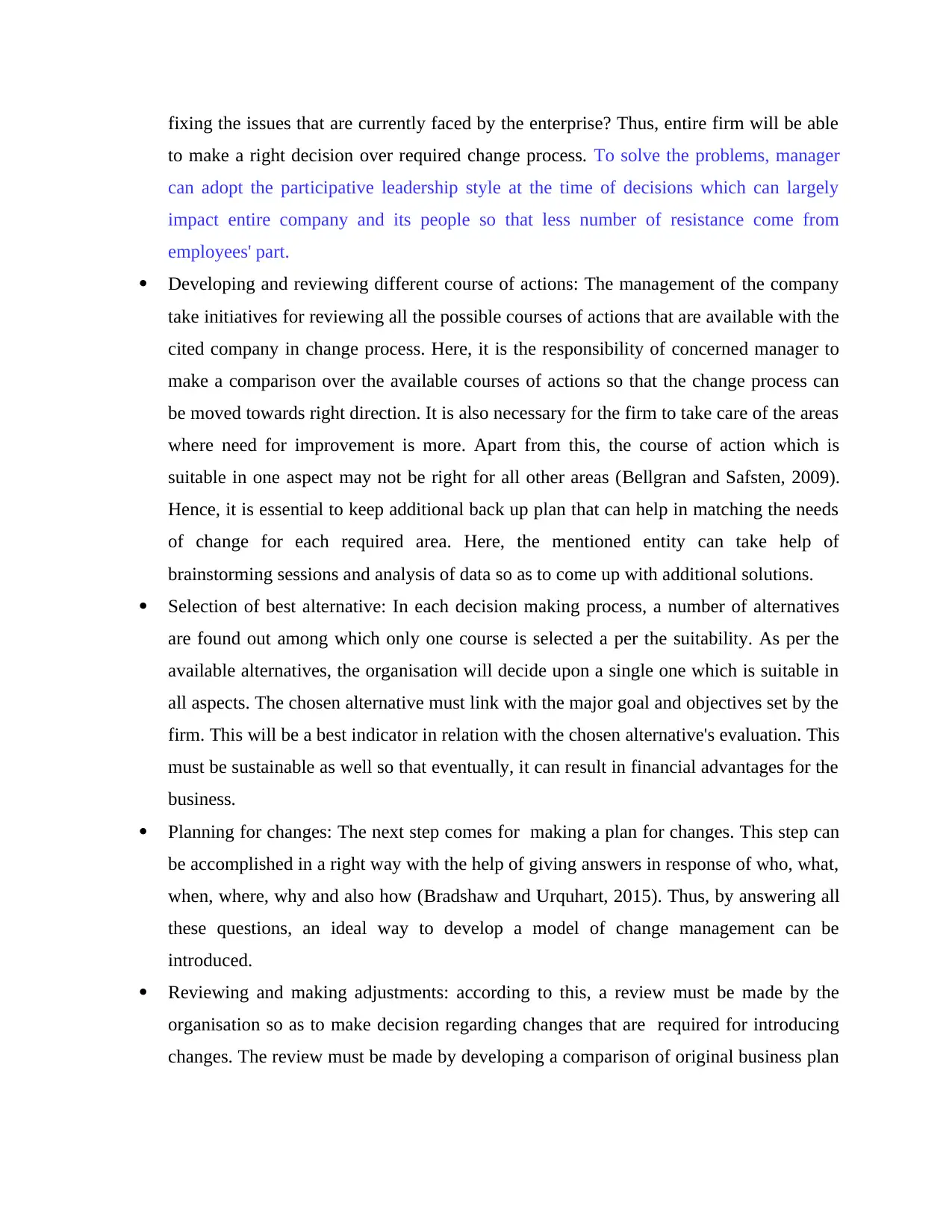
fixing the issues that are currently faced by the enterprise? Thus, entire firm will be able
to make a right decision over required change process. To solve the problems, manager
can adopt the participative leadership style at the time of decisions which can largely
impact entire company and its people so that less number of resistance come from
employees' part.
Developing and reviewing different course of actions: The management of the company
take initiatives for reviewing all the possible courses of actions that are available with the
cited company in change process. Here, it is the responsibility of concerned manager to
make a comparison over the available courses of actions so that the change process can
be moved towards right direction. It is also necessary for the firm to take care of the areas
where need for improvement is more. Apart from this, the course of action which is
suitable in one aspect may not be right for all other areas (Bellgran and Safsten, 2009).
Hence, it is essential to keep additional back up plan that can help in matching the needs
of change for each required area. Here, the mentioned entity can take help of
brainstorming sessions and analysis of data so as to come up with additional solutions.
Selection of best alternative: In each decision making process, a number of alternatives
are found out among which only one course is selected a per the suitability. As per the
available alternatives, the organisation will decide upon a single one which is suitable in
all aspects. The chosen alternative must link with the major goal and objectives set by the
firm. This will be a best indicator in relation with the chosen alternative's evaluation. This
must be sustainable as well so that eventually, it can result in financial advantages for the
business.
Planning for changes: The next step comes for making a plan for changes. This step can
be accomplished in a right way with the help of giving answers in response of who, what,
when, where, why and also how (Bradshaw and Urquhart, 2015). Thus, by answering all
these questions, an ideal way to develop a model of change management can be
introduced.
Reviewing and making adjustments: according to this, a review must be made by the
organisation so as to make decision regarding changes that are required for introducing
changes. The review must be made by developing a comparison of original business plan
to make a right decision over required change process. To solve the problems, manager
can adopt the participative leadership style at the time of decisions which can largely
impact entire company and its people so that less number of resistance come from
employees' part.
Developing and reviewing different course of actions: The management of the company
take initiatives for reviewing all the possible courses of actions that are available with the
cited company in change process. Here, it is the responsibility of concerned manager to
make a comparison over the available courses of actions so that the change process can
be moved towards right direction. It is also necessary for the firm to take care of the areas
where need for improvement is more. Apart from this, the course of action which is
suitable in one aspect may not be right for all other areas (Bellgran and Safsten, 2009).
Hence, it is essential to keep additional back up plan that can help in matching the needs
of change for each required area. Here, the mentioned entity can take help of
brainstorming sessions and analysis of data so as to come up with additional solutions.
Selection of best alternative: In each decision making process, a number of alternatives
are found out among which only one course is selected a per the suitability. As per the
available alternatives, the organisation will decide upon a single one which is suitable in
all aspects. The chosen alternative must link with the major goal and objectives set by the
firm. This will be a best indicator in relation with the chosen alternative's evaluation. This
must be sustainable as well so that eventually, it can result in financial advantages for the
business.
Planning for changes: The next step comes for making a plan for changes. This step can
be accomplished in a right way with the help of giving answers in response of who, what,
when, where, why and also how (Bradshaw and Urquhart, 2015). Thus, by answering all
these questions, an ideal way to develop a model of change management can be
introduced.
Reviewing and making adjustments: according to this, a review must be made by the
organisation so as to make decision regarding changes that are required for introducing
changes. The review must be made by developing a comparison of original business plan
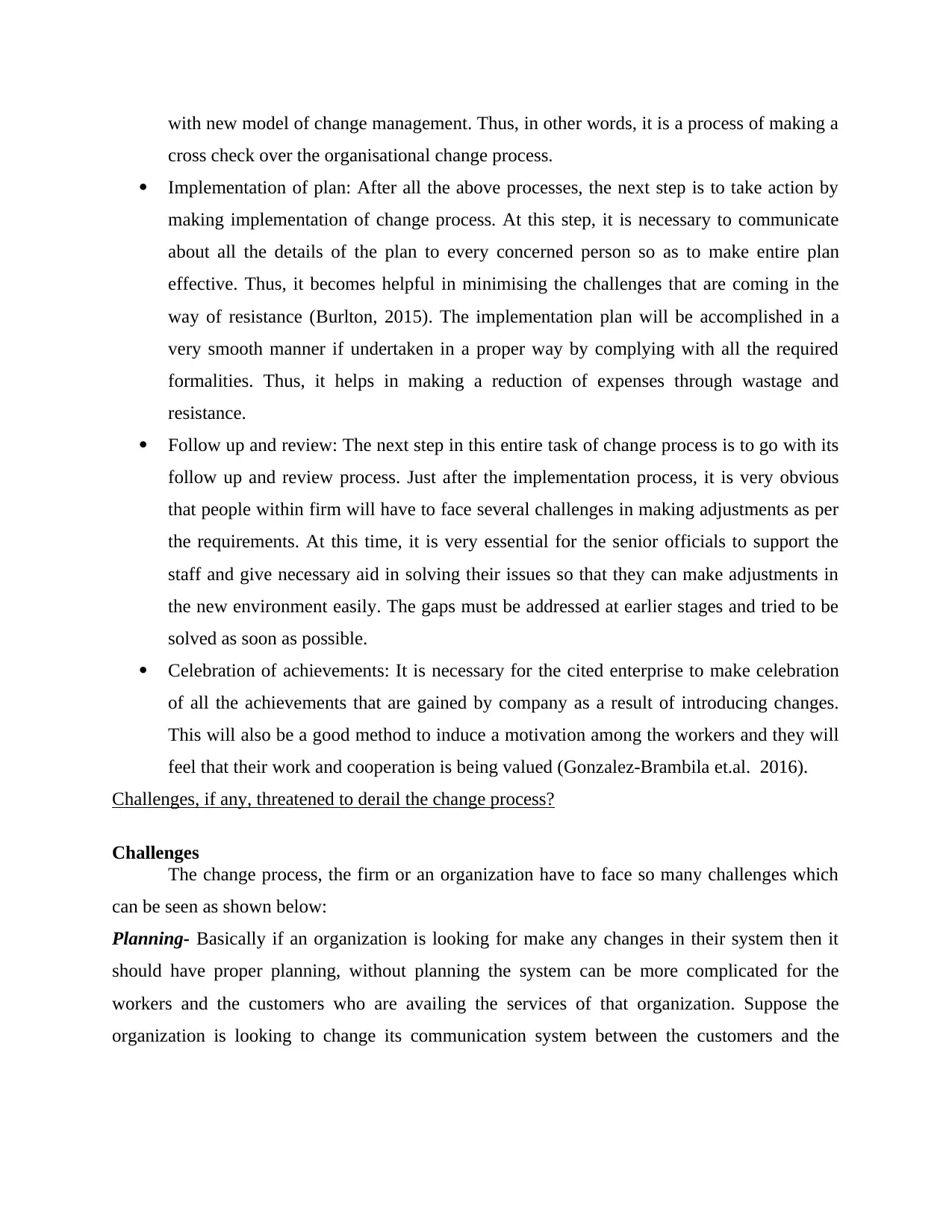
with new model of change management. Thus, in other words, it is a process of making a
cross check over the organisational change process.
Implementation of plan: After all the above processes, the next step is to take action by
making implementation of change process. At this step, it is necessary to communicate
about all the details of the plan to every concerned person so as to make entire plan
effective. Thus, it becomes helpful in minimising the challenges that are coming in the
way of resistance (Burlton, 2015). The implementation plan will be accomplished in a
very smooth manner if undertaken in a proper way by complying with all the required
formalities. Thus, it helps in making a reduction of expenses through wastage and
resistance.
Follow up and review: The next step in this entire task of change process is to go with its
follow up and review process. Just after the implementation process, it is very obvious
that people within firm will have to face several challenges in making adjustments as per
the requirements. At this time, it is very essential for the senior officials to support the
staff and give necessary aid in solving their issues so that they can make adjustments in
the new environment easily. The gaps must be addressed at earlier stages and tried to be
solved as soon as possible.
Celebration of achievements: It is necessary for the cited enterprise to make celebration
of all the achievements that are gained by company as a result of introducing changes.
This will also be a good method to induce a motivation among the workers and they will
feel that their work and cooperation is being valued (Gonzalez-Brambila et.al. 2016).
Challenges, if any, threatened to derail the change process?
Challenges
The change process, the firm or an organization have to face so many challenges which
can be seen as shown below:
Planning- Basically if an organization is looking for make any changes in their system then it
should have proper planning, without planning the system can be more complicated for the
workers and the customers who are availing the services of that organization. Suppose the
organization is looking to change its communication system between the customers and the
cross check over the organisational change process.
Implementation of plan: After all the above processes, the next step is to take action by
making implementation of change process. At this step, it is necessary to communicate
about all the details of the plan to every concerned person so as to make entire plan
effective. Thus, it becomes helpful in minimising the challenges that are coming in the
way of resistance (Burlton, 2015). The implementation plan will be accomplished in a
very smooth manner if undertaken in a proper way by complying with all the required
formalities. Thus, it helps in making a reduction of expenses through wastage and
resistance.
Follow up and review: The next step in this entire task of change process is to go with its
follow up and review process. Just after the implementation process, it is very obvious
that people within firm will have to face several challenges in making adjustments as per
the requirements. At this time, it is very essential for the senior officials to support the
staff and give necessary aid in solving their issues so that they can make adjustments in
the new environment easily. The gaps must be addressed at earlier stages and tried to be
solved as soon as possible.
Celebration of achievements: It is necessary for the cited enterprise to make celebration
of all the achievements that are gained by company as a result of introducing changes.
This will also be a good method to induce a motivation among the workers and they will
feel that their work and cooperation is being valued (Gonzalez-Brambila et.al. 2016).
Challenges, if any, threatened to derail the change process?
Challenges
The change process, the firm or an organization have to face so many challenges which
can be seen as shown below:
Planning- Basically if an organization is looking for make any changes in their system then it
should have proper planning, without planning the system can be more complicated for the
workers and the customers who are availing the services of that organization. Suppose the
organization is looking to change its communication system between the customers and the
⊘ This is a preview!⊘
Do you want full access?
Subscribe today to unlock all pages.

Trusted by 1+ million students worldwide
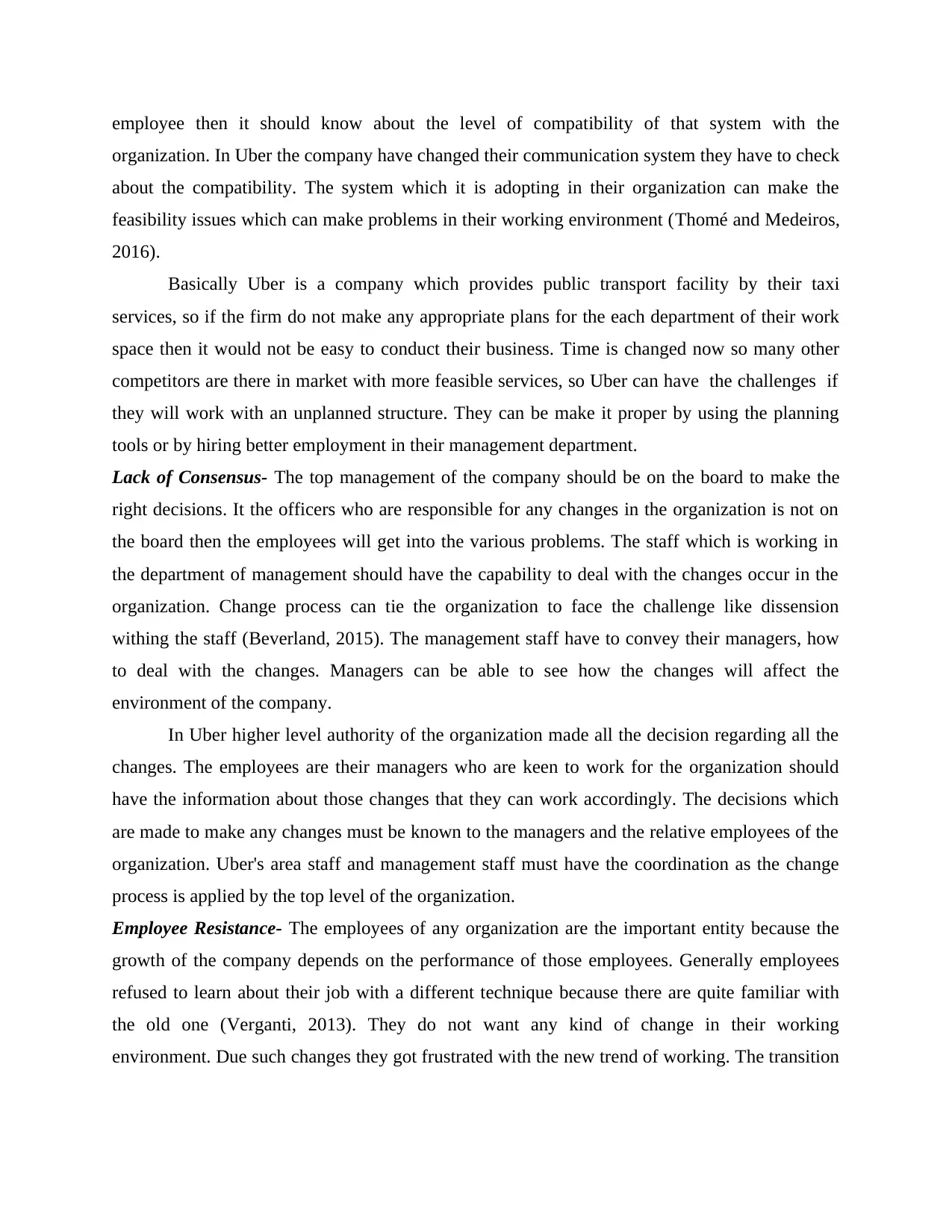
employee then it should know about the level of compatibility of that system with the
organization. In Uber the company have changed their communication system they have to check
about the compatibility. The system which it is adopting in their organization can make the
feasibility issues which can make problems in their working environment (Thomé and Medeiros,
2016).
Basically Uber is a company which provides public transport facility by their taxi
services, so if the firm do not make any appropriate plans for the each department of their work
space then it would not be easy to conduct their business. Time is changed now so many other
competitors are there in market with more feasible services, so Uber can have the challenges if
they will work with an unplanned structure. They can be make it proper by using the planning
tools or by hiring better employment in their management department.
Lack of Consensus- The top management of the company should be on the board to make the
right decisions. It the officers who are responsible for any changes in the organization is not on
the board then the employees will get into the various problems. The staff which is working in
the department of management should have the capability to deal with the changes occur in the
organization. Change process can tie the organization to face the challenge like dissension
withing the staff (Beverland, 2015). The management staff have to convey their managers, how
to deal with the changes. Managers can be able to see how the changes will affect the
environment of the company.
In Uber higher level authority of the organization made all the decision regarding all the
changes. The employees are their managers who are keen to work for the organization should
have the information about those changes that they can work accordingly. The decisions which
are made to make any changes must be known to the managers and the relative employees of the
organization. Uber's area staff and management staff must have the coordination as the change
process is applied by the top level of the organization.
Employee Resistance- The employees of any organization are the important entity because the
growth of the company depends on the performance of those employees. Generally employees
refused to learn about their job with a different technique because there are quite familiar with
the old one (Verganti, 2013). They do not want any kind of change in their working
environment. Due such changes they got frustrated with the new trend of working. The transition
organization. In Uber the company have changed their communication system they have to check
about the compatibility. The system which it is adopting in their organization can make the
feasibility issues which can make problems in their working environment (Thomé and Medeiros,
2016).
Basically Uber is a company which provides public transport facility by their taxi
services, so if the firm do not make any appropriate plans for the each department of their work
space then it would not be easy to conduct their business. Time is changed now so many other
competitors are there in market with more feasible services, so Uber can have the challenges if
they will work with an unplanned structure. They can be make it proper by using the planning
tools or by hiring better employment in their management department.
Lack of Consensus- The top management of the company should be on the board to make the
right decisions. It the officers who are responsible for any changes in the organization is not on
the board then the employees will get into the various problems. The staff which is working in
the department of management should have the capability to deal with the changes occur in the
organization. Change process can tie the organization to face the challenge like dissension
withing the staff (Beverland, 2015). The management staff have to convey their managers, how
to deal with the changes. Managers can be able to see how the changes will affect the
environment of the company.
In Uber higher level authority of the organization made all the decision regarding all the
changes. The employees are their managers who are keen to work for the organization should
have the information about those changes that they can work accordingly. The decisions which
are made to make any changes must be known to the managers and the relative employees of the
organization. Uber's area staff and management staff must have the coordination as the change
process is applied by the top level of the organization.
Employee Resistance- The employees of any organization are the important entity because the
growth of the company depends on the performance of those employees. Generally employees
refused to learn about their job with a different technique because there are quite familiar with
the old one (Verganti, 2013). They do not want any kind of change in their working
environment. Due such changes they got frustrated with the new trend of working. The transition
Paraphrase This Document
Need a fresh take? Get an instant paraphrase of this document with our AI Paraphraser
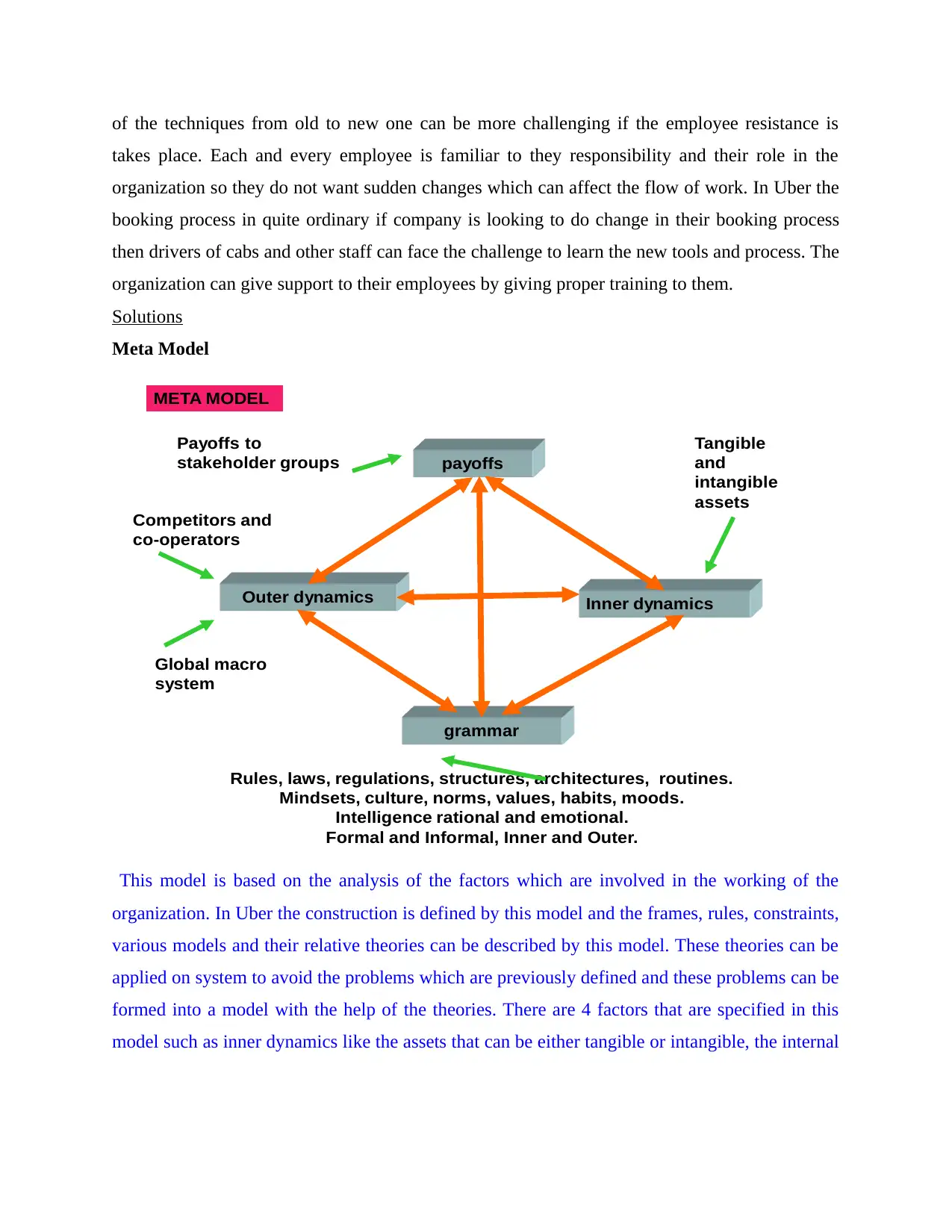
of the techniques from old to new one can be more challenging if the employee resistance is
takes place. Each and every employee is familiar to they responsibility and their role in the
organization so they do not want sudden changes which can affect the flow of work. In Uber the
booking process in quite ordinary if company is looking to do change in their booking process
then drivers of cabs and other staff can face the challenge to learn the new tools and process. The
organization can give support to their employees by giving proper training to them.
Solutions
Meta Model
Inner dynamics
payoffs
Outer dynamics
grammar
Payoffs to
stakeholder groups
Global macro
system
Rules, laws, regulations, structures, architectures, routines.
Mindsets, culture, norms, values, habits, moods.
Intelligence rational and emotional.
Formal and Informal, Inner and Outer.
Tangible
and
intangible
assets
Competitors and
co-operators
META MODEL
This model is based on the analysis of the factors which are involved in the working of the
organization. In Uber the construction is defined by this model and the frames, rules, constraints,
various models and their relative theories can be described by this model. These theories can be
applied on system to avoid the problems which are previously defined and these problems can be
formed into a model with the help of the theories. There are 4 factors that are specified in this
model such as inner dynamics like the assets that can be either tangible or intangible, the internal
takes place. Each and every employee is familiar to they responsibility and their role in the
organization so they do not want sudden changes which can affect the flow of work. In Uber the
booking process in quite ordinary if company is looking to do change in their booking process
then drivers of cabs and other staff can face the challenge to learn the new tools and process. The
organization can give support to their employees by giving proper training to them.
Solutions
Meta Model
Inner dynamics
payoffs
Outer dynamics
grammar
Payoffs to
stakeholder groups
Global macro
system
Rules, laws, regulations, structures, architectures, routines.
Mindsets, culture, norms, values, habits, moods.
Intelligence rational and emotional.
Formal and Informal, Inner and Outer.
Tangible
and
intangible
assets
Competitors and
co-operators
META MODEL
This model is based on the analysis of the factors which are involved in the working of the
organization. In Uber the construction is defined by this model and the frames, rules, constraints,
various models and their relative theories can be described by this model. These theories can be
applied on system to avoid the problems which are previously defined and these problems can be
formed into a model with the help of the theories. There are 4 factors that are specified in this
model such as inner dynamics like the assets that can be either tangible or intangible, the internal
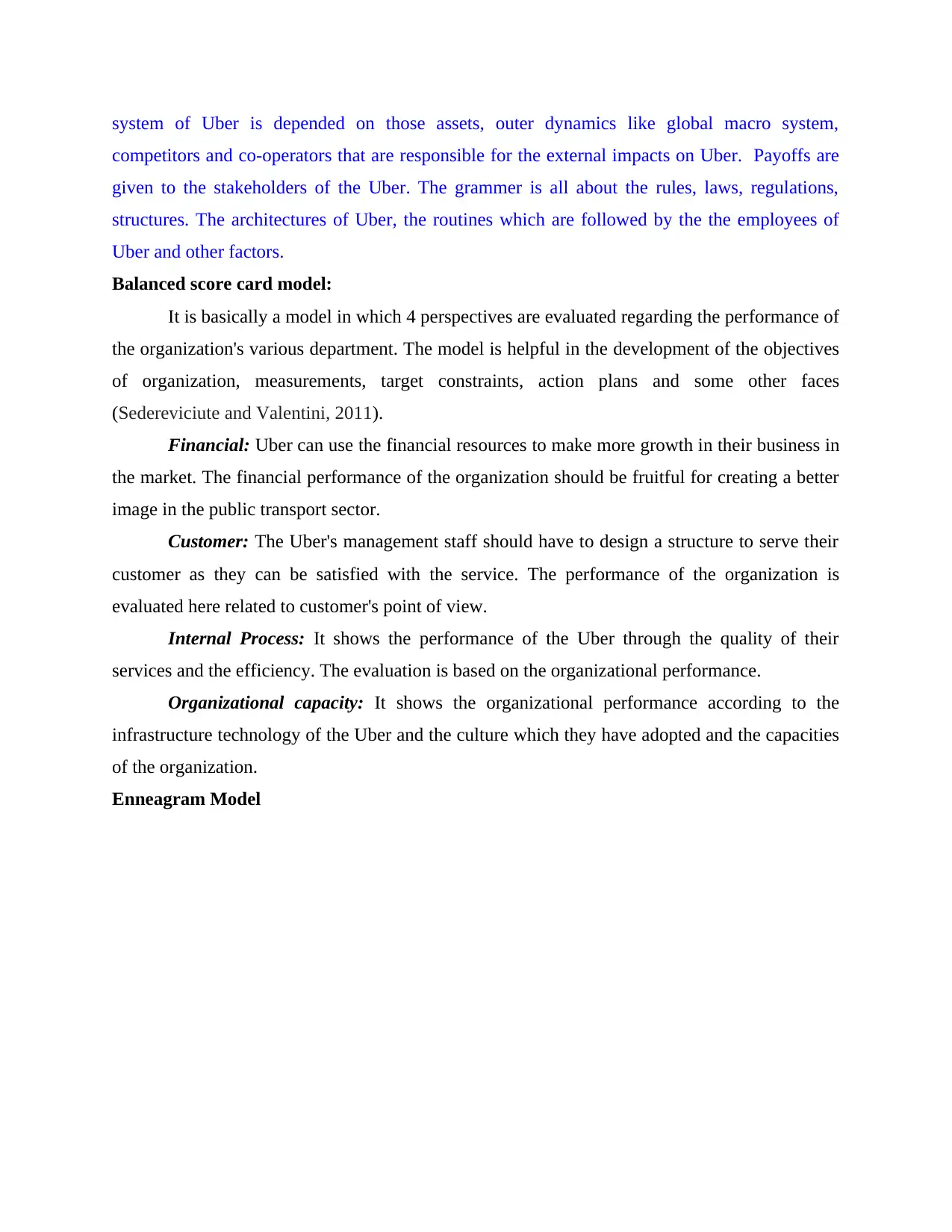
system of Uber is depended on those assets, outer dynamics like global macro system,
competitors and co-operators that are responsible for the external impacts on Uber. Payoffs are
given to the stakeholders of the Uber. The grammer is all about the rules, laws, regulations,
structures. The architectures of Uber, the routines which are followed by the the employees of
Uber and other factors.
Balanced score card model:
It is basically a model in which 4 perspectives are evaluated regarding the performance of
the organization's various department. The model is helpful in the development of the objectives
of organization, measurements, target constraints, action plans and some other faces
(Sedereviciute and Valentini, 2011).
Financial: Uber can use the financial resources to make more growth in their business in
the market. The financial performance of the organization should be fruitful for creating a better
image in the public transport sector.
Customer: The Uber's management staff should have to design a structure to serve their
customer as they can be satisfied with the service. The performance of the organization is
evaluated here related to customer's point of view.
Internal Process: It shows the performance of the Uber through the quality of their
services and the efficiency. The evaluation is based on the organizational performance.
Organizational capacity: It shows the organizational performance according to the
infrastructure technology of the Uber and the culture which they have adopted and the capacities
of the organization.
Enneagram Model
competitors and co-operators that are responsible for the external impacts on Uber. Payoffs are
given to the stakeholders of the Uber. The grammer is all about the rules, laws, regulations,
structures. The architectures of Uber, the routines which are followed by the the employees of
Uber and other factors.
Balanced score card model:
It is basically a model in which 4 perspectives are evaluated regarding the performance of
the organization's various department. The model is helpful in the development of the objectives
of organization, measurements, target constraints, action plans and some other faces
(Sedereviciute and Valentini, 2011).
Financial: Uber can use the financial resources to make more growth in their business in
the market. The financial performance of the organization should be fruitful for creating a better
image in the public transport sector.
Customer: The Uber's management staff should have to design a structure to serve their
customer as they can be satisfied with the service. The performance of the organization is
evaluated here related to customer's point of view.
Internal Process: It shows the performance of the Uber through the quality of their
services and the efficiency. The evaluation is based on the organizational performance.
Organizational capacity: It shows the organizational performance according to the
infrastructure technology of the Uber and the culture which they have adopted and the capacities
of the organization.
Enneagram Model
⊘ This is a preview!⊘
Do you want full access?
Subscribe today to unlock all pages.

Trusted by 1+ million students worldwide
1 out of 24
Related Documents
Your All-in-One AI-Powered Toolkit for Academic Success.
+13062052269
info@desklib.com
Available 24*7 on WhatsApp / Email
![[object Object]](/_next/static/media/star-bottom.7253800d.svg)
Unlock your academic potential
Copyright © 2020–2025 A2Z Services. All Rights Reserved. Developed and managed by ZUCOL.





